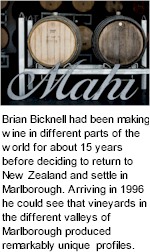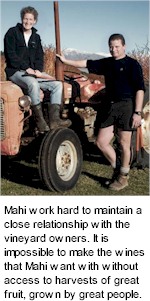


Brian Bicknell had been making wine in different parts of the world for about 15 years before deciding to return to New Zealand and settle in Marlborough. Arriving in 1996 he could see that vineyards in the different valleys of Marlborough produced remarkably unique profiles. At the time, most of Marlborough’s wines were made as regional blends with many individual site characteristics being lost. In other areas of the world distinctive sites were being celebrated and so an idea was hatched to create a label that promoted different vineyard sites across Marlborough to show the region had true depth and complexity. Wine reflects both the place and the people involved, you can have a great site, but if the management is poor, or the owners too greedy, then this will be reflected in the fruit and the wines.

Brian’s winemaking style for Mahi is to allow the vineyards to speak through the wines, with the wines being made in a very hands off manner. The primary emphasis for all of Mahi’s wines is texture, aiming for wines that give real palate satisfaction rather than fruit bomb styles. The very first harvest was from a vineyard located in the Conder’s Bend part of Marlborough. An area Brian was familiar with. Initial quantities were tiny from this small 1.5 hectare parcel of Sauvignon Blanc and Pinot Noir from the Byrne vineyard. Mahi now manages the vineyard organically and are thrilled to still be working with the site that started it all.
In 2003 Twin Valleys Vineyard was included into the Mahi family. Located at Fareham Lane in a distinctive part of Wairau Valley, an area of slightly cooler temperatures and longer ripening times. A series of elegant Chardonnays have come from this parcel. From 2006 onwards Pinot Noir and Gewurztraminer have also been made. In 2007 the owners purchased a site close by at Guernsey Lane and planted it to Sauvignon Blanc.
In 2004 an opportunity to take some Sauvignon Blanc from a vineyard closer to the sea presented itself and since then the Francis Vineyard Sauvignon Blanc has been produced. The Francis family has a long history with Brian and Nicola as Polly Francis had worked five vintages with Brian and worked the first vintage at the Mahi winery in 2007.

Having a winery was a long held dream as it allowed for total control of the winemaking process and also gave Mahi a home. The first vintage of Mahi in its new home was 2007. A lease of an excellent vineyard was taken up and another very good grower was also added. The greater numbers of vineyards meant that the focus at Mahi was broadened and in 2007 the first regional Marlborough Sauvignon Blanc was produced.
Mahi work hard to maintain a close relationship with the vineyard owners. It is possible to make okay wines from mediocre grapes but it is impossible to make the wines that Mahi want to be associated with without access to great fruit, grown by great people. It is the key to be associated with people who have the right sites, vineyards which are planted with the appropriate varieties, growers with the passion and experience to manage the vineyard so that great grapes are produced. It is an art and a science to manage a vineyard through a season and as each season is different from the others, good growers learn something new every year. With this in mind, the Mahi team acknowledge the impact that experience has on making particular decisions for a parcel of land.
If someone has been working with the same parcel over many years, they build up a real knowledge of how their vines will respond to different seasons. It is a matter of great pride at Mahi that they are still involved with the vineyard which kicked Mahi off, the Byrne property on Bedford Road. Mahi may also mention that they are still associated with all the growers they have ever worked with. At the Mahi cellar door are photos and stories of all the growers, you can taste the wines while reading the stories of these special places and people.
